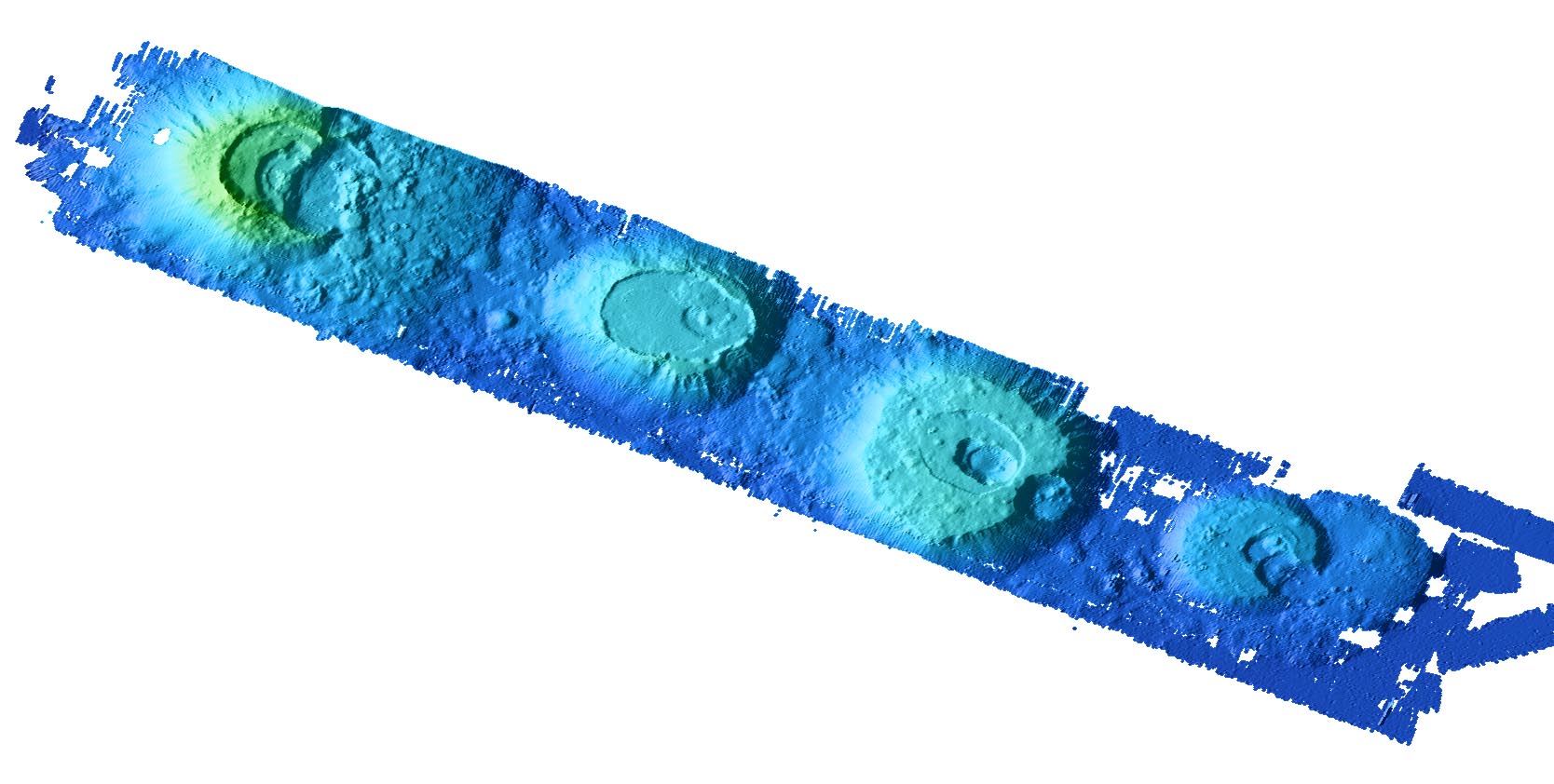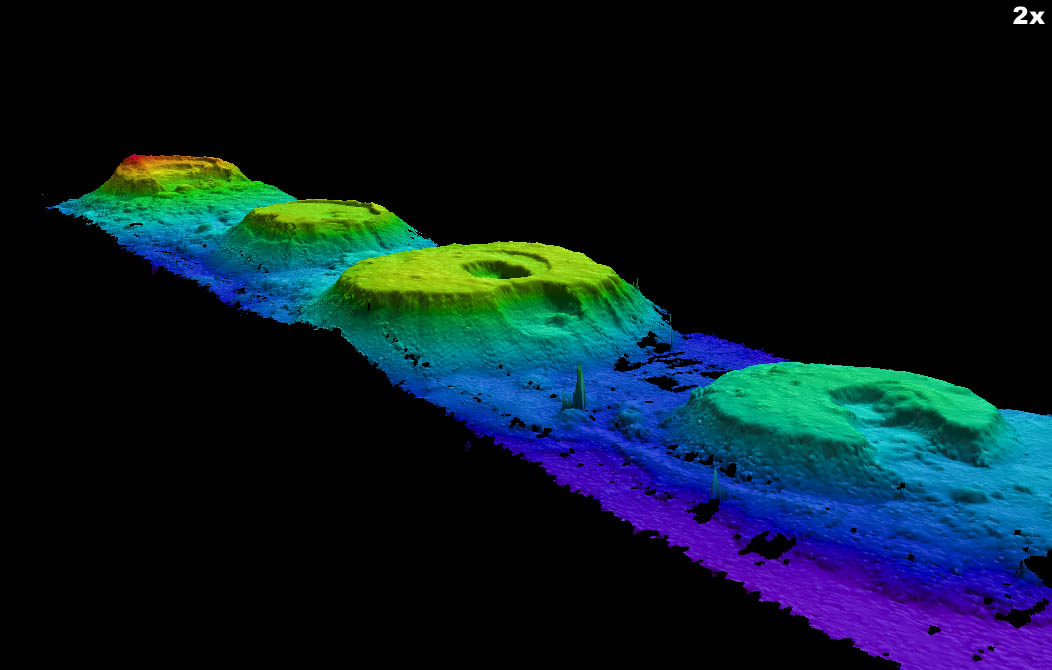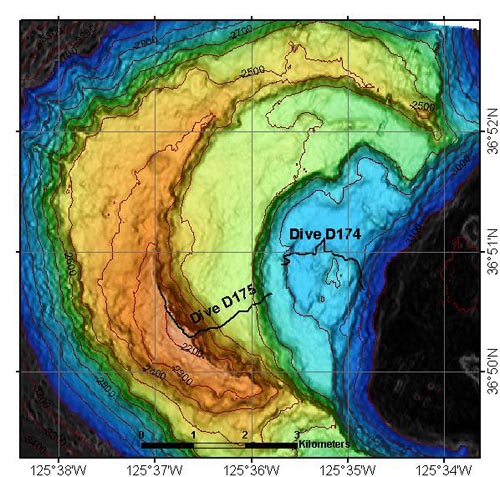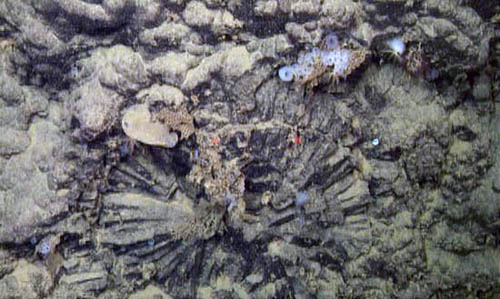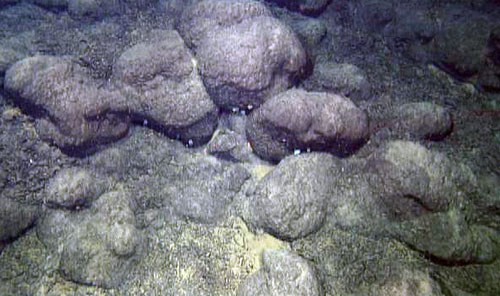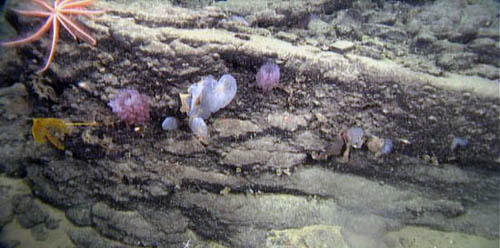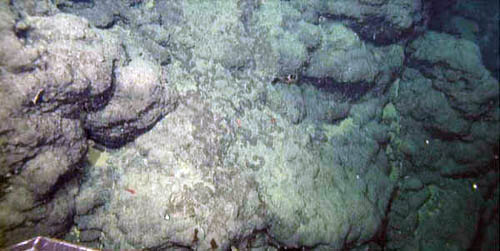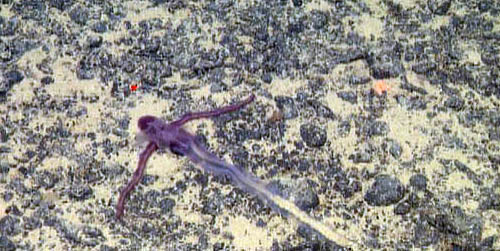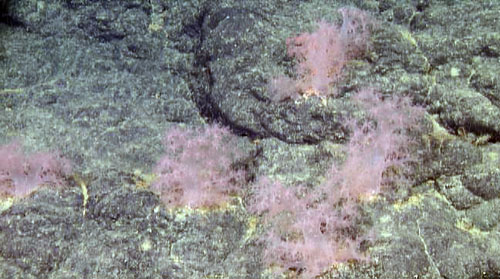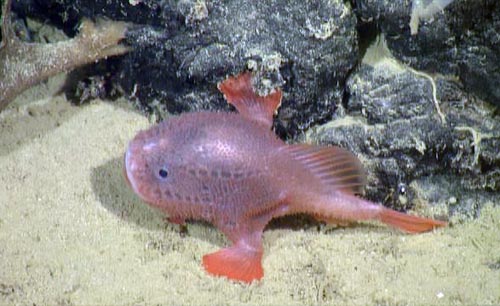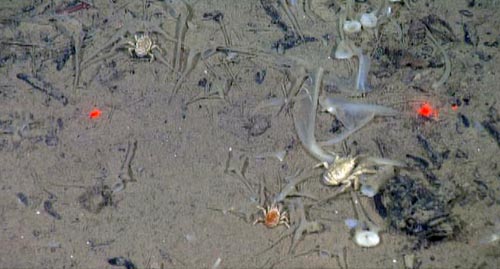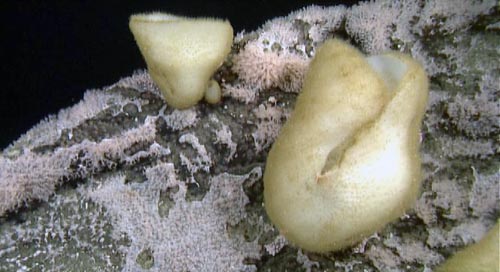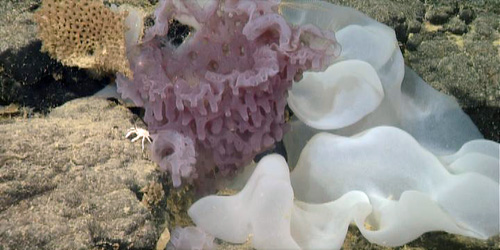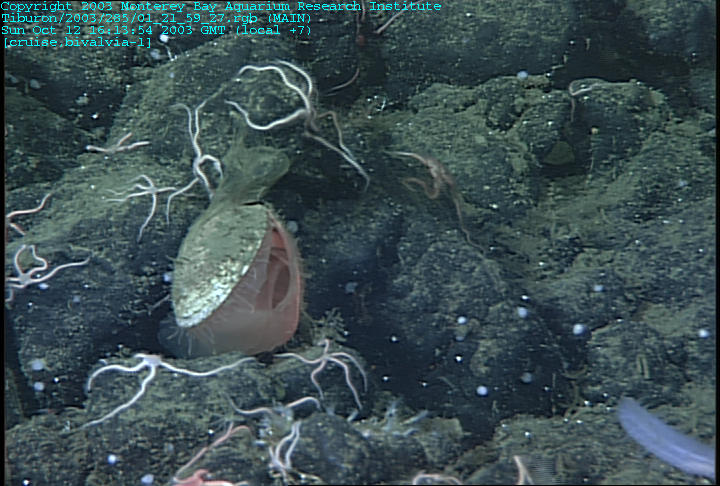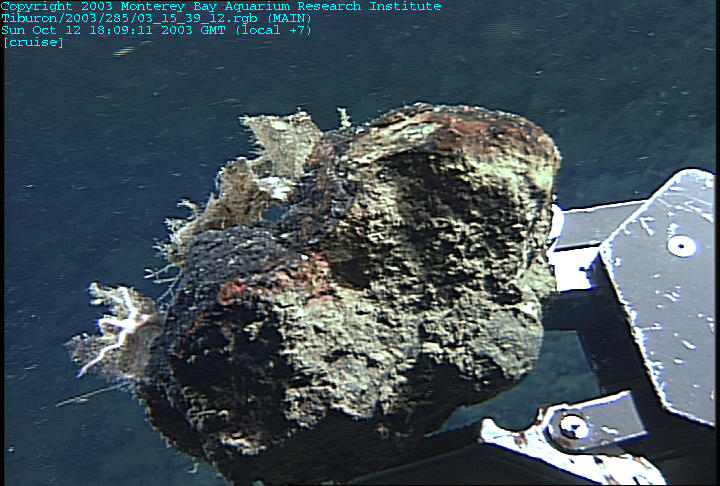 | Taney Seamounts |
|
Taney Seamounts perspective view from the south-southeast |
Map of Taney Seamount A showing our dive tracks today and yesterday (black lines). The dive today began close to where yesterday''s ended, climbed two caldera walls, and traversed along the rim of the western-most, oldest caldera. The color range of the bathymetry data is from 3080 to 2130 meters depth to emphasize the features on this part of the seamount -http://www.mbari.org/expeditions/Taney10/logbook/day5.htm |
Pillow lava - http://www.mbari.org/expeditions/Taney10/logbook/day8.htm |
Pillow lava. While it is refreshing to see recognizable lava flow shapes, intact pillow lavas, heavily coated with manganese oxide crusts and sediment, are extremely challenging to sample -http://www.mbari.org/expeditions/Taney10/logbook/day6.htm |
Volcanic clastic material: At the very top of the outer caldera was a thick, layered unit of volcanic fragmental material, deposited after the caldera collapsed. Here it provides substrate for purple and white sponges, a stalked crinoid, and large brisingid star - http://www.mbari.org/expeditions/Taney10/logbook/day8.htm |
Thick manganese-oxide crusts precipitated from hydrothermal fluids when the volcano was active and from seawater over time since, making it hard to discern the original rock textures - http://www.mbari.org/expeditions/Taney10/logbook/day2.htm |
An enterpneust feeds on sediment among manganese-nodule gravel and leaves behind a trail of feces. These worms are hemichordates, of the phylum Chordata, to which we belong. The red laser dots are 29 cm apart for scale -http://www.mbari.org/expeditions/Taney10/logbook/day2.htm |
http://www.mbari.org/expeditions/Taney10/logbook/day7.htm- Gersemia juliepackardae is a beautiful, feathery, pink soft coral, here living on manganese-encrusted volcaniclastic rock at the rim of the Taney A caldera. It has been found on Southern California seamounts, in Monterey Bay, and north to the Olympic Peninsula National Marine Sanctuary, from 500 meters to now 2,500 meters depth (this observation is a depth range extension for this animal). It was first described in 2009 by Williams and Lundsten and named in honor of Julie Packard, head of the Monterey Bay Aquarium and chair of our board of directors, for her dedication to ocean stewardship, outreach, and education |
http://www.mbari.org/expeditions/Taney10/logbook/day7.htm - This 10-centimeter-long polynoid polychaete worm of the genus Laetmonice, which we fondly call the Liberace Worm, is relatively abundant at these depths. It can raise its sharp bristles like a porcupine. The bristles have been shown to be effective fiber-optic-lightwave guides. However, our specimens did not bioluminesce in the lab, which one might expect of this adaptation. This group of worms has pincer-like jaws at the far end of the pharynx. They invert the pharynx to eat, reaching out and exposing the jaws. A fearsome predator and not easy prey |
The so-ugly-it''s-cute toad fish (Chaunacops coloratus) dangles a lure from its head to attract prey. It can walk along the seafloor using its fins. We have seen this fish once before, perched similarly at Davidson Seamount |
Remains of a feast: the vertebrae and other bones of some unknown fish are being picked over by several galatheid crabs and scale worms. The red lasers are set 29 centimeters apart for scale -http://www.mbari.org/expeditions/Taney10/logbook/day5.htm |
On the otherwise nearly barren summit of the seamount, we found impressive numbers of octocorals (pink) and sponges (white) carpeting this one boulder. The sponge in the foreground is about 50 centimeters tall- http://www.mbari.org/expeditions/Taney10/logbook/day5.htm |
After seeing few sponges on Taney Seamount B, today we were delighted to find several that are unfamiliar to us, including this lovely purple goiter sponge - http://www.mbari.org/expeditions/Taney10/logbook/day4.htm |
An octopus swims by |
This clam lives like a brachiopod, attached to rocks with a clump of threads called a byssus. We have seen these on Davidson Seamount and the President Jackson Seamounts off Gorda Ridge, and we expect to see them on Rodriguez Seamount if we get deep enough -text - http://www.mbari.org/expeditions/Seamounts03/October12.htm |
Basaltic lava rock, sampled with the manipulator. This rock has a thin layer of volcanic glass on the top surface (not easily seen in the photo, but obvious upon a closer look on deck). The lava quenched upon contact with the cold seawater, trapping the gas and mineral composition of the melt in the glassy surface. So analyzing the glass, if it hasn''t been altered too badly over the ~10 million years since it erupted, will give insight into the eruption conditions, such as depth, temperature, and whether the magma was stored for long in a magma chamber before it erupted |
Glass sponge, festooned with crinoids, and home to a small shrimp (seen peeping from within the sponge in the lower center). These crinoids, also known as "feather stars," can swim. Other crinoids we saw today have tall stalks and can crawl if knocked over |
MBARI - http://www.mbari.org/data/mapping/seamounts/taney.htm
The Taney Seamounts are located on the Pacific Plate, west of San Francisco. It is unknown whether a symmetrical chain of volcanoes existed on the subducted Farallon Plate. GLORIA imagery (Geological Long-Range Inclined Asdic, EEZ-Scan 84 Scientific Staff, 1986, 1988) shows that the chain does not extend beyond the region that we have imaged. The Taney Seamounts were incorrectly inferred to be young volcanoes based on their morphology (EEZ-Scan 1984 Scientific Staff, 1988). However, an Ar-Ar age of approximately 26 million years for volcano T-A (G.B. Dalrymple, cited in Davis et al., 1998) demonstrates that their age is close to that of the underlying seafloor. Dredges on the northwestern volcano in the chain have recovered E-MORB and mildly alkalic pillow basalts (Davis et al., 1998), and MBARI has recently done ROV dives on two of the volcanoes. The following descriptions are summarized from Clague et al. (2000), who analyzed the Simrad data presented here in detail.
The Taney Seamounts consist of five aligned volcanoes. The volcanoes have an average volume of 86±64 km3, range 11 to 187 km3. The northwestern volcano is by far the largest volcano in the chain, with a calculated volume of 187 km3. The volcano has been so severely modified by three successive caldera collapses that most of the summit platform has been destroyed. The southeastern portion of the floor of the third and southeastern caldera has been modified by eruptions that formed many 0.5-1.0 kilometer diameter cones and several roughly 1-kilometer diameter low, flat-topped shields. The large embayment north of the southeastern caldera may be caused by a landslide or by faulting along a ridge-parallel fault.
The summit of the next volcano to the southeast is an unusual large caldera, about 6.5 by 4.5 kilometers. The volcano is oval, with the long axis parallel to the chain. The rim of the large caldera varies in height up to about 150 meters tall. The east-southeastern rim has been overtopped by lava flows erupted within the caldera that flowed from the floor down the flank, and then ponded at the base of the slope to form a lava delta. A small step on the southern flank of the volcano, seen as an illuminated band about halfway up the flank, may be a sommathe rim of an even earlier, and larger, caldera that was almost entirely filled by a subsequent shield. The next volcano to the southeast has three oval calderas with their long dimension parallel to the chain. The southeastern caldera dropped the southeastern rim of the summit by about 575 meters. The eastern rim of the summit platform is scalloped, apparently by several landslides. A pit crater in the northwestern part of the flat summit of the fourth volcano from the northwest is less than 100 meters across and about 60 meters deep. Unlike the other 13 calderas, this is the only collapse feature in the Taney Seamounts that is less than 1.5 kilometers in diameter.
from http://en.wikipedia.org/wiki/Taney_Seamounts
The Taney Seamounts are a range of five extinct underwater volcanoes located 300 kilometres (160 nmi; 190 mi) west of San Francisco on the Pacific Plate.
from http://www.mbari.org/expeditions/Taney10/
The Taney Seamounts are a chain of four volcanoes that lie 180 nautical miles (333 kilometers) due west of Monterey Bay. They formed about 26 million years ago near a mid-ocean ridge that is no longer actively spreading. They have thick deposits of fragmental volcanic debris on the flanks and very large, overlapping calderas, evidence of repeated explosive eruptions and caldera collapse. We will conduct seven ROV dives along the caldera floors and walls of the seamounts.
Dave writes: The calderas flanked by thick deposits of fragmental volcanic rocks is a pattern we have observed elsewhere, such as at Axial Volcano on the Juan de Fuca Ridge, and at the Vance Seamounts just west of that same ridge, where the youngest rocks on the rim of the caldera are made of volcanic fragments. Such deposits are indicative of explosive eruptive activity rather than the widely observed effusive lava flows. These much younger seamounts are not encrusted with such thick Mn-oxides, making it much easier to sample and to see what the rocks really are. Next week we will really find out what we have managed to collect when we cut each sample on a diamond saw.
Ascending the tallest caldera wall, we encountered an active talus slope with huge angular lava unencumbered by manganese crusts, so very easy to collect. Above that was a sheer cliff of truncated bulbous and lobate pillow flows. It had shed the talus recently enough that it, too, had little manganese, so was recognizable as well as collectable. The rose-like pattern in the photo is from radial jointing that occurred as a bulbous lava pillow cooled and shrank. The pillow was truncated by the caldera collapse and subsequent instability of the cliff face.
Sarah writes: Little work has been done on soft-sediment habitats on seamounts, with much attention being paid to the larger, eye-catching organisms on hard bottom areas like sponges and corals. In order to describe the seamount community as a whole and understand how it may be different than similar habitat on the continental shelf, we are trying to figure out what organisms live in the soft-sediment areas as well. Marine sediments (even in the deep sea) are typically full of tiny organisms that are difficult to see without the help of a microscope. Small worms are usually the dominant members of the sediment community (many are relatives of the Liberace worm we collected.
John writes: A key focus of this trip to the Taneys is calderas. Calderas form when a subsurface magma chamber is drainedeither partially or completelyduring an eruption, causing the roof of the chamber to collapse into the chamber. All four seamounts show caldera development, but the caldera style is very different from one seamount to the next. Why is this so? Calderas are well-known products of super-eruptions whereby large amounts of silica-rich and gas-rich magma are erupted by huge explosive eruptions. A good example is Yellowstone. The resulting deposits can encompass huge volumes, including pumice falls and pyroclastic flows.
The Taney calderas are different. The magma is basaltic in composition, with less silica and less gas. This makes the eruptions less explosive or even non-explosive in nature, as shown by the large amount of lava which is present. Another interesting difference is that the amount of magma erupted at the surface appears to be small relative to the size of some of the calderas. If so, where did the magma which drained the chamber end up?
This is a common phenomenon at basaltic calderas, both on land and beneath the sea. At Kilauea volcano on Hawaii, magma can drain underground through rift zones connected to the summit region. At Miyakejima Island in Japan, a caldera formed progressively during the summer of 2000, with magma draining from the underground chamber through a crack that propagated in the ocean crust tens if not hundreds of kilometers to the west.
Processes such as these may have been important for the Taney caldera systems. We want to better understand caldera development by studying their characteristics such as shape and size, as well as the mineralogy and chemistry of the magmas which were erupted from the subsurface magma chambers.
Jenny writes: Today the weather improved enough, and we got in a full dive on Taney Seamount A. The dive began by ascending to the top of the wall of the eastern-most and youngest caldera of four overlapping calderas on this volcano. On the floor of the caldera to which we climbed, we traversed some steep-sided hills that turned out to be mounds of elongate pillows built by low-effusivity eruptions. From there we diverted to a flat, featureless area on the map, and cored into the thick sediments accumulated there, in case this location might yield a long paleo-climate record of California. We continued over to and up the wall of that caldera, sampling loose talus as we went, as in-place rocks are well-cemented by thick manganese-oxide crusts. We collected 21 rocks in all on this dive, but the biologists won out with 34 animal collections, mostly sea stars for genetic analysis.
Although we executed the dive as planned, thick manganese crusts (up to several inches thick) obscured most of the rocks making sampling a challenge. Much of the outer caldera rim appears to consist of volcaniclastic rocks, based on the presence of eroded pits and depressions. However, we were unable to collect this material with the manipulator, except for one sample of fine volcanic mud/siltstone under the manganese crust. The interior floor of the caldera was buried beneath fine pelagic sediment with a thin surface layer of small irregularly shaped manganese nodules, and the talus and outcrops on the caldera walls were also blanketed in thick manganese crusts. On the steepest caldera wall we finally encountered some pillow lava cross-sections and collected a few nice pillow wedges.
The animal community consists of many individuals of relatively few species, compared with the diverse communities on seamounts such as Davidson and Pioneer, located closer to shore. We saw several specimens of a large purple-colored enteropneust (acorn worm), abundant small pale pink sea stars, and equally abundant palm-frond sponges on the steeper slopes. Corals were very rare with only a few antipatharians (black corals) and Keratoisis sp. (bamboo corals) observed during the dive. Large sponges were notably absent. Other animals included a variety of colorful holothurians (sea cucumbers) in reds and purples, as well as white and transparent ones, a variety of gastropods, several colorful purple or orange anemones, stalked and un-stalked crinoids, and abundant small red shrimp.
In the end, we collected only 16 rock samples, close to a low for any dive we have done, seven push-cores to be processed for small animals living in the sediment, and roughly a dozen larger animals. We also executed three biology transects to quantify the animals present at these depths and compare with others done at seamounts elsewhere. The dive was in part a work-out-the-bugs dive, as we lost navigation for a while, had problems with drift in the pan-and-tilt on the science camera, with the swing arm (so we could not get to use some longer cores we had brought along), and with the animal suction sampler that prevented any animals from being collected using that sampler. However, the few rock samples collected include some thick manganese-oxide crusts and a collection of lavas, as we had hoped. One lava sample has a glass rind, which is better than we had hoped. These are the first such samples ever collected from this seamount.
Dave writes: Todays dive targeted a series of cones on the oldest seamounts youngest and deepest caldera floor. These cones consisted mostly of constructional bulbous pillow lavas encased in some seven centimeters of manganese crusts, making them exceedingly difficult to sample. We collected 25 rocks from four cones. Plenty were pillow wedges (fractured along the radially symmetrical cooling cracks), which will have relatively unaltered interiors and be good for chemistry. Despite trying hard to avoid them, seven samples consisted only of manganese crusts and three were erratics
